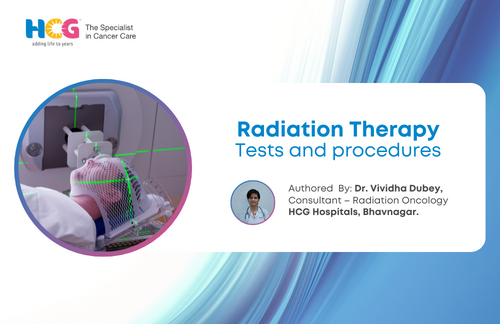December 1, 2022
Dr. Vividha Dubey, Radiation Oncology

Overview
Radiation therapy is a type of cancer treatment that uses beams of intense energy to kill cancer cells. Radiation therapy most often uses X-rays, but protons or other types of energy also can be used.
Radiation therapy can be either identified as teletherapy (External beam) or Brachytherapy (Internal beam). In teletherapy during radiation, high energy beams come from machines at a distance from the body. In Brachytherapy, radiation source is placed inside the body.
Radiation therapy damages cancer cells by destroying the genetic material that controls how cells grow and divide.
Why it’s done
Radiation therapy forms the essence of treatment in most types of cancer. It is also useful for treatments of some benign (Noncancerous) tumors.
How radiation therapy is used in people with cancer
Your doctor may suggest radiation therapy as an option at different times during your cancer treatment and for different reasons, including:
- As the only (primary) treatment for cancer
- Before surgery, to shrink a cancerous tumor (neoadjuvant therapy)
- After surgery, to stop the growth of any remaining cancer cells (adjuvant therapy)
- In combination with other treatments, such as chemotherapy, to destroy cancer cells
- In advanced cancer to alleviate symptoms caused by the cancer (Palliative therapy).
Risks
Radiation therapy side effects depend on which part of your body is being exposed to radiation and how much radiation is used. You may experience no side effects, or you may experience some side effects. Most side effects are temporary, can be controlled and generally disappear over time once treatment has ended.
| Part of body being treated | Common side effects |
| Any part | Skin irritation at treatment site |
| Head and neck | Dry mouth, thickened saliva, changes in the way food tastes, Oral ulcers. |
| Chest | Difficulty swallowing, cough |
| Abdomen | Nausea, vomiting, diarrhea |
| Pelvis | Diarrhea, bladder irritation, frequent urination |
Side effects can be early or late and usually occurs after completion of treatment. Ask your doctor about potential side effects, both short and long term, that may occur after your treatment.
How you prepare
Before you undergo external beam radiation therapy, your health care team guides you through a planning process to ensure precise dose delivery by radiation in your body. where it’s needed. Planning typically includes:
- Radiation simulation: During simulation, your radiation therapy team works with you to find a comfortable position for you during treatment. It’s imperative that you lie still during treatment, so finding a comfortable position is vital. To do this, you’ll lie on the same type of table that’s used during radiation therapy. Cushions and restraints are used to position you in the right way and to help you hold still. Your radiation therapy team will mark the area of your body that will receive the radiation. Depending on your situation, you may receive temporary marking with a marker or you may receive small permanent tattoos.
- Planning scans : Your radiation therapy team will have you undergo computerized tomography (CT) scans to determine the area of your body to be treated.
The precise dose and focus of radiation beams used in your treatment is carefully planned to maximize the radiation to your cancer cells and minimize the harm to surrounding healthy tissue.
What you can expect
External beam radiation therapy is usually conducted using a linear accelerator — a machine that directs high-energy beams of radiation into your body.
As you lie on a table, the linear accelerator moves around you to deliver radiation from several angles. The linear accelerator can be adjusted for your particular situation so that it delivers the precise dose of radiation in order to achieve maximum effect of dose delivery.
You typically receive external beam radiation on an outpatient basis five days a week over a certain period of time. In most instances, treatments are usually spread out over several weeks to allow your healthy cells to recover in between radiation therapy sessions.
In some cases, a single treatment may be used to help relieve pain or other symptoms associated with more-advanced cancers.
You’ll lie still and breathe normally during the treatment, which takes only a few minutes. For some patients with lung or breast cancer, you might be asked to hold your breath while the machine delivers the treatment.
Your radiation therapy team stays nearby in a room with video and audio connections so that you can talk to each other. You should speak up if you feel uncomfortable, but you shouldn’t feel any pain during your radiation therapy session.
Results
If you’re receiving radiation to a tumor, your doctor may have you undergo periodic scans after your treatment to see how your cancer has responded to radiation therapy.
Even after completion of treatment, regular follow ups of periodic scans are done for assuring tumor control. Aim of radiation treatment, be it curative and palliative and response of treatment depends on the stage of presentation at time of treatment.

